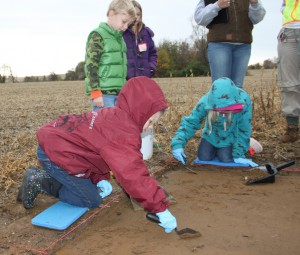
This week at Whispering Woods was our big event – Open Archaeology Day! Friday’s class was a run-through with the Salem County 4-H club coming for a visit at 10am. We were expecting around 15 children, mostly K-3rd grade, to spend about an hour digging.
When we arrived on Friday it was WET! Rains from the day before had inundated our three open excavation units. Despite being covered with tarps, water had soaked through or ran into the units as we attempted to lift off the tarps. Once the Rutgers students arrived at 9am, they spent the first hour bailing out the units and excavating out the muck.
Units 2 and 3 were placed over two of Site 4’s positive STPs (our STPs). In one we had found some cream ware and in the other we found red ware and some bone. These units weren’t terribly important so they were set aside for the 4-H-ers to excavate.
EU 4 was located in an area with positive STPs from the Phase I survey. This unit was showing disturbed soil and an area of buried wood. This unit was reserved for Saturday’s open day.

The children arrived bang on 10am. There were a lot of them and they were eager to dig! Just as they were assigned their tasks (3 diggers, 3 screeners, 2 to run buckets), it started to rain! Our first rain of the semester. Thankfully, it didn’t last.
After rotating the kids a few times, I decided to take small groups into the woods to see the stream and to thin out the crowded units.
Soon it was time for them to go. All were muddy but happy and satisfied. They had found brick and coal, a few pieces of ceramic, and a big chunk of glazed drainage pipe. The EUs were looking a little worse-for-wear but a little flat-blade shoveling cleaned them up and squared them off in no time.
Saturday was a million times easier! The skies were fair, the visitors were older, and we had all three units available. Most participants arrived right at the start so by mid-afternoon it was pretty light. We had the pleasure of meeting a lot of families from the local area, many of whom had found artifacts on their property. In fact one of the 4-H visitors came back on Saturday with an amazing display of projectile points, hammer stones, all kinds of amazing things, all found on her land. Sadly, though, without knowing the context of each artifact they can not inform the archaeological record; they are just pretty to look at. Hopefully, though, after Saturday’s exercise, our visitors left with a greater appreciation and understanding of what archaeologists do and what we do it that way.
